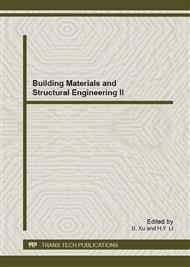[1]
I. Hanashiro, J. Abe, S. Hizukuri. A periodic distribution of the chain length of amylopectin as revealed by high-performance anion-exchange chromatography. Carbohydrate Research. 283(1996)151-159.
DOI: 10.1016/0008-6215(95)00408-4
Google Scholar
[2]
N. Charoenkul, D. Uttapap, W. Pathipanawat, Y. Takeda. Simultaneous determination of amylose content & unit chain distribution of amylopectins of cassava starches by fluorescent labeling/HPSEC. Carbohydrate Polymers. 65(2006)102-108.
DOI: 10.1016/j.carbpol.2005.12.030
Google Scholar
[3]
A. H. Schulman, S. Tomooka, A. Suzuki, P. Myllarinen, S. Hizukuri. Structural analysis of starch from normal and shx (shrunken endosperm) barley (Hordeum vulgare L. ). Carbohydrate Research. 275(1995)361-369.
DOI: 10.1016/0008-6215(95)00169-t
Google Scholar
[4]
S. Sayar, M. Turhan, H. Koksel. Application of unreacted-core model to in situ gelatinization of chickpea starch. Journal of Food Engineering. 60(2003)349-356.
DOI: 10.1016/s0260-8774(03)00057-8
Google Scholar
[5]
D. Fessas, A. Schiraldi. Starch gelatinization kinetics in bread dough DSC investigations on simulated, baking processes. Journal of Thermal Analysis and Calorimetry. 61(2000)411-423.
DOI: 10.1023/a:1010161216120
Google Scholar
[6]
S. Sagol, M. Turhan, S. Sayar. A potential method for determining in situ gelatinization temperature of starch using initial water transfer rate in whole cereals. Journal of Food Engineering. 76(2006)427-432.
DOI: 10.1016/j.jfoodeng.2005.05.042
Google Scholar
[7]
M. A. Gavrielidou, N. A. Vallous, T. D. Karapantsios, S. N. Raphaelides. Heat transport to a starch slurry gelatinizing between the drums of a double drum dryer. Journal of Food Engineering. 54(2002)45-58.
DOI: 10.1016/s0260-8774(01)00184-4
Google Scholar
[8]
T. Palav, K. Seetharaman. Mechanism of starch gelatinization and polymer leaching during microwave heating. Carbohydrate Ploymers. 65(2006)364-370.
DOI: 10.1016/j.carbpol.2006.01.024
Google Scholar
[9]
M. Tako, S. Hizukuri. Gelatinization mechanism of potato starch. Carbohydrate Polymers. 48(2002)397-401.
DOI: 10.1016/s0144-8617(01)00287-9
Google Scholar
[10]
T. S. Nordmark, G. R. Ziegler. Spherulitic crystallization of gelatinized maize starch and its fraction. Carbohydrate Polymers. 49(2002)439-448.
DOI: 10.1016/s0144-8617(01)00353-8
Google Scholar
[11]
R. Parker, S. G. Ring. Aspects of the physical chemistry of starch. Journal of Cereal Science. 34(2001)1-17.
Google Scholar
[12]
N. J. Atkin, R. M. Abeysekera, A. W. Robards. The events leading to the formation of ghost remnants from the starch granule surface and the contribution of the granule surface to the gelatinization endotherm. Carbohydrate Polymers. 36(1998).
DOI: 10.1016/s0144-8617(98)00002-2
Google Scholar
[13]
K. Pielichowski, P. Tomasik, M. Sikora. Kinetics of gelatinization of potato starch studied by non-isothermal DSC. Carbohydrate Polymers. 35(1998)49-54.
DOI: 10.1016/s0144-8617(97)00236-1
Google Scholar
[14]
B. E. Verlinden, B. M. Nicolai, J. D. Baerdemaeker. The starch gelatinization in potatoes during cooking in relation to the modelling of texture kinetics. Journal of Food Engineering. 24(1995)165-179.
DOI: 10.1016/0260-8774(94)p2641-h
Google Scholar
[15]
G. Spigno, D. M. De Faveri. Gelatinization kinetics of rice starch studied by non-isothermal calorimetric technique: infulence of extraction method, water concentration and heating rate. Journal of Food Engineering. 62(2004)337-344.
DOI: 10.1016/s0260-8774(03)00248-6
Google Scholar
[16]
E. Purlis. Baking process design based on modelling and simualtion: Towards optimization of bread baking. Food Control. 27(2012)45-52.
DOI: 10.1016/j.foodcont.2012.02.034
Google Scholar
[17]
E. Purlis. Bread baking: Technological considerations based on process modelling and simulation. Journal of Food Engineering. 103(2011)92-102.
DOI: 10.1016/j.jfoodeng.2010.10.003
Google Scholar
[18]
S. Y. Wong, W. Zhou, J. Hua. Designing process controller for a continuous bread baking process based on CFD modelling. Journal of Food Engineering. 81(2007)523-534.
DOI: 10.1016/j.jfoodeng.2006.12.006
Google Scholar
[19]
N. Therdthai, W. Zhou, T. Adamczak. Simulation of starch gelatinisation during baking in a travelling-tray oven by integrating a three-dimensional CFD model with a kinetic model. Journal of Food Engineering. 65(2004)543-550.
DOI: 10.1016/j.jfoodeng.2004.02.018
Google Scholar
[20]
N. Chhanwal, A. Tank, K. S. M. S. Raghavarao, C. Anandharamakrishnan. Computational fluid dynamics (CFD) modeling for bread baking process-a review. Food Bioprocess Technol. 5(2012)1157-1172.
DOI: 10.1007/s11947-012-0804-y
Google Scholar


